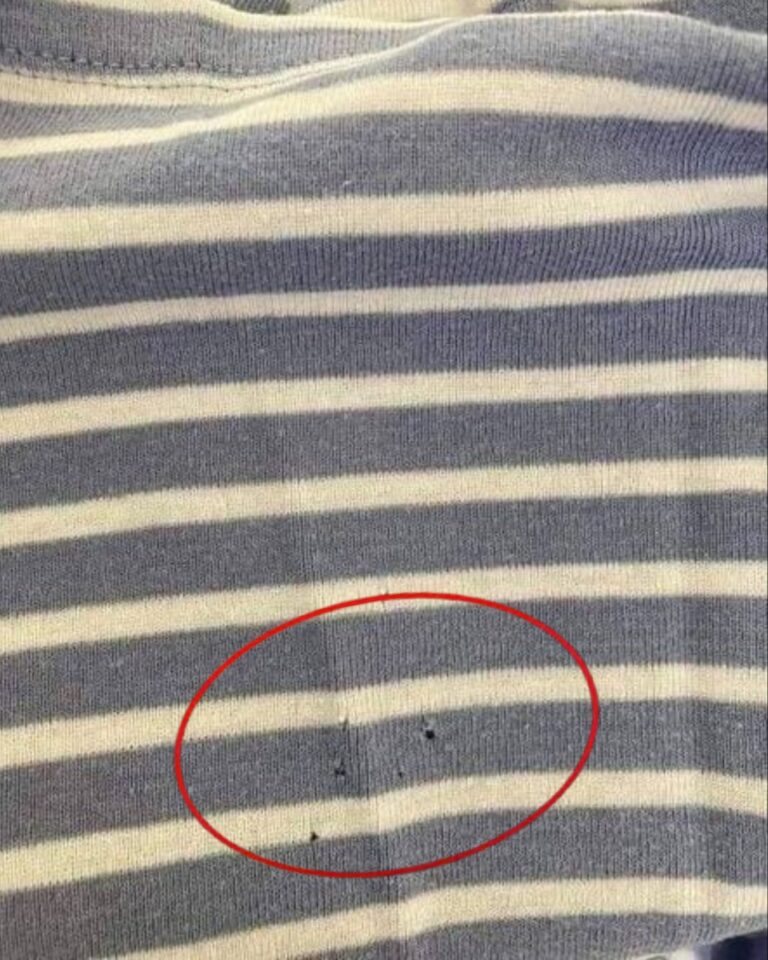ADVERTISEMENT
If You Spot These Holes in Your Clothes, Here’s What You Need to Know!
Finding holes in your clothes can be frustrating, especially when you realize they are not just random rips. Sometimes, these holes are the result of a specific issue, whether it’s the fabric, the way the clothing is washed, or external factors you may not have considered. But don’t worry! The good news is that most of these holes are preventable, and in many cases, they’re fixable.
In this article, we’ll explore the most common types of holes you may find in your clothes, what causes them, and how to prevent and fix them. Let’s dive in so you can keep your wardrobe in tip-top shape!
1. Holes from Moths: A Sneaky Culprit
One of the most common types of holes found in clothes is moth holes. Moths are drawn to natural fibers, such as wool, silk, and cashmere, and they lay their eggs in the fabric. The larvae hatch and feed on the fibers, creating small, irregular holes in your clothes.
How to Spot Moth Holes:
- The holes are typically round and irregular in shape.
- Moth holes often appear on delicate, natural-fiber fabrics such as wool sweaters or coats.
- You may notice a fine, powdery residue around the holes, which is moth larvae excrement.
How to Prevent and Treat Moth Damage:
- Prevention: Store clothes in airtight containers or garment bags during off-seasons. Use cedar blocks or mothballs to deter moths, or try lavender sachets as a natural alternative.
- Treatment: If you discover moth holes, it’s essential to treat the clothing immediately. Wash the fabric in hot water (if safe for the fabric) and dry it in the sun. For heavier garments like wool coats, a professional dry cleaning may be necessary. To repair small moth holes, consider darning or using a patch to cover the damaged area.
2. Holes from Friction: Wear and Tear
Friction holes occur when your clothing rubs against something repeatedly, causing the fabric to weaken and eventually tear. These holes are common in areas that experience constant movement, such as the inner thighs, underarms, or cuffs.
How to Spot Friction Holes:
- These holes are usually located in areas that experience a lot of movement or pressure.
- They are typically small and often appear as thin, worn spots before becoming full-blown holes.
- You may notice the fabric feels thin or slightly stretched before the hole appears.
How to Prevent and Treat Friction Holes:
- Prevention: Wear underwear or tights to prevent friction on areas like the inner thighs. For pants, you can also try fabric patches on high-friction areas. Reinforce fabric in areas of frequent wear with iron-on patches or seam tape.
- Treatment: Friction holes can be repaired by reinforcing the fabric with fabric glue or a patch, especially if the hole is small. For larger holes, consider sewing a patch or bringing the item to a tailor for a more durable fix.
3. Holes from Washing and Drying: The Laundry Trap
Your washing machine and dryer can be surprisingly tough on clothing, especially if you’re not following proper care instructions. Overloading the machine, using harsh detergents, or drying clothes on high heat can weaken fabrics and cause holes.
How to Spot Washing and Drying Holes:
- These holes often appear in areas that were under stress, such as the sides or seams of the clothing.
- The fabric around the hole might appear more fragile or worn down, especially if the fabric has been subjected to rough cycles in the washing machine or dryer.
- Small, pin-sized holes can sometimes appear from the fabric rubbing against itself or the washing machine drum.
How to Prevent and Treat Washing and Drying Holes:
- Prevention: Always follow the care labels on your clothes, paying attention to temperature settings for both washing and drying. Use a gentle cycle for delicate fabrics and avoid overloading the machine. Consider air-drying clothes whenever possible, or use a low-heat setting in the dryer.
- Treatment: If you notice a hole from washing, you can repair it by darning, patching, or using fabric glue. If the damage is extensive, it may be time to repurpose the item into something new, like turning a worn-out shirt into a trendy scarf or patchwork design.
4. Holes from Shoes: The Back of Your Heels
Have you ever noticed small holes or worn spots at the back of your heels or at the toes of your shoes? These holes are likely caused by friction from your shoes. Shoes that fit poorly or rub against certain parts of your clothing can cause wear and tear.
How to Spot Shoe-Related Holes:
- Holes usually appear around areas where your clothing comes into contact with shoes, such as the heels or around the toe area.
- The holes may be concentrated around seams or other high-stress areas.
- For Complete Cooking STEPS Please Head On Over To Nex
